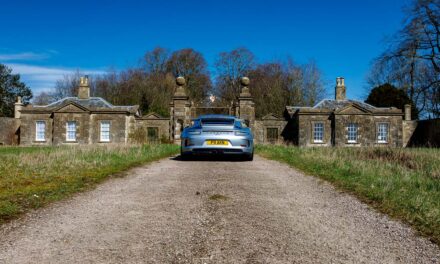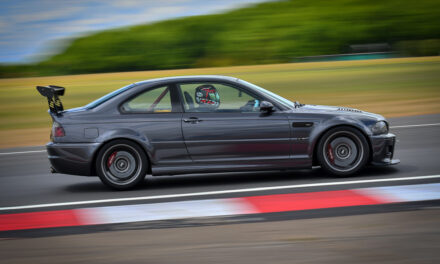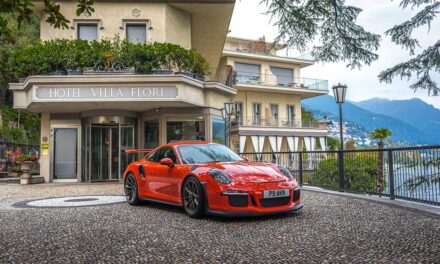I was quite disappointed I was not able to take my current car, a Porsche 911 GT3 onto the hallowed track of the Nurburgring’s Nordschleife (North Loop) circuit during our most recent visit. I describe that trip in this article and explain why I could not do so. I started working on a plan to return with a more suitable car almost before that trip ended, as I was so determined to return and tackle the ‘Green Hell’ before the end of the year.
To the ‘Green Hell’.
I wanted something I could drive to any race track and then drive hard on the track. It had to be fully track-prepared but still be road-legal. It also had to retain a modicum of comfort. By ‘track-prepared’, I mean the car must have a roll cage in a track-prepared body, have track-capable brakes and suspension, and racing bucket seats and harness. It would ideally also have all the unnecessary weight stripped out and would have had most of the performance upgrades done. Not a lot eh?
After looking at a few cars, I found an absolute belter, a BMW E46 M3 at Geoff Steel. The car’s specification is detailed later on.
Geoff Steel himself delivered the car to me late on the last Thursday in October and I duly set off on the 700km journey from my house in West London to the Nurburgring in the late afternoon the very next day.
The first 600km of the journey was uneventful with nothing to report, but with just under 100km to go, the heavens opened, filling the motorways with deadly pools of standing water. Normally, using regular road tyres, this would not be a problem, but I was in a track-ready monster running semi-slick tyres that handled motorway standing water badly. Very badly.
I somehow managed to slither at much-reduced speed to my fantastically-named ‘GT3 Hotel’ in Adenau just before 11 pm.
The GT3 Hotel
Is there a better name for a motorsport-themed hotel than the ‘GT3 Hotel’? I do not think so. Situated in the hills above Adenau town center, it is a mere 14-minute drive to the racetrack and is perfect as a base for any ‘Ring trip.
It is also appropriately decorated with motorsport pictures and art and has motorsport memorabilia and collectibles almost everywhere you look.
For this petrolhead, having breakfast next to a large-scale model Mercedes AMG CLK GTR was the perfect start to the day.
The day got even better as I walked to the car park and saw the stunning views from it. How does this place manage to blend the mechanical brutality at the ‘Ring (and the ferocious cars) with the natural beauty of the Eiffel region? How have they managed to maintain such a serene balance?
I continued to ponder this question as I drove to the track.
Touristenfahrten
I’d chosen another Nurburgring Nordschleife ‘Tourist Day’ weekend for my first-ever driving laps of the ‘Green Hell’, the famous nickname bestowed on this track by the three-time F1 Champion, Sir Jackie Stewart.
A Tourist Day or Touristenfahrten means “Public driving” and is a tradition that dates back to the very birth of the circuit in 1927. These sessions are available on both the Nurburgring Nordschleife and Nurburgring GP Track and the astonishing thing is that ANYONE can turn up in ANY road-legal car, pay 30 euros and do a lap on THE most dangerous, most thrilling track on the planet! The rules of the road, such as overtaking only on the left apply. The simplicity of it all is one of this event’s most attractive features.
I arrived at a closed track just after 9 am. The incessant rain had forced the closure of the track much to my relief. I did not fancy doing my first-ever ‘Ring lap on a wet track while using semi-slick tyres. I was driving a new car which was so different from the cars I have driven over the last 10 years, with an unfamiliar setup, using unfamiliar Nankang AR-1 tyres on an unfamiliar track. Wet weather was another variable I could do without. The Nurburgring is a daunting track in the dry and wet weather elevates the risk levels by a few notches.
This enforced delay to all track action enabled me to park up, purchase my ‘Green Hell’ card and link it to the mobile app. It also allowed me to peruse the array of serious cars casually parked around waiting to be let loose on the track. Honestly, the Nurburgring is to car lovers and racing enthusiasts what a fried chicken convention is to a fat kid, or to use the politically correct term, a ‘horizontally-challenged’ kid.
It is always that good. There are always serious performance cars at a Tourist Day, as well as the not-so-serious and downright incongruous cars. The sight of an 8-seat VW passenger van mixing it with the powerful track-ready, bewinged machinery on track is both refreshing and hilarious at the same time. The really quick guys see such cars as nothing more than a nuisance and another obstacle to overcome in the pursuit of a quick lap.
The First Lap
At 10 am, the gate entry lights went from red to green, signaling the opening of the track session. I did not immediately venture onto the track as I was waiting for the track to dry out a bit. One racer from the VLN racing championship (a German endurance championship) had taken one look at my nearly-slick tyres and advised me to wait for a dryish line. I thought it would be wise to heed his advice.
One hour later, the track was dry enough for me to venture out, so I did up my seat harness, put on my helmet and gloves and drove through the barriers onto the famous tarmac of the ‘Green Hell’.
Tiergarten to Hocheichen. It is a flat-out blast out of the gates to the first real corners of the track but instead of turning right to bypass the GP Circuit as normal, the track went straight on to the GP track and I found myself on Michael Schumacher’s old stomping ground. We would be using the VLN layout which included a lot of the GP track as well! Brilliant!
This only further increased the challenge at hand because while I had made efforts to learn the normal Nordschleife track, I had almost no idea about the GP track apart from what I’d learned from watching the German Grand Prix on TV.
Luckily, there was an instructor in a car behind so I let them past and used them as a guide for this section of the track. The GP track used consisted of a high-speed straight, followed by a tight right-hander then a left-hand bowl-like section which then leads onto a tight right-hander, then a short straight, then a 180-degree right-hand enlarged hairpin, followed by a left turn before hitting a fast, flowing section which then takes us back to rejoin the Nordschleife.
Blasting past the empty grandstands of the Nurburgring Grand Prix track was an amazing experience and I can only wonder what it would have been like to pilot a Ferrari F1 car at full chat with grandstands packed full with flag-waving Tifosi.
Quiddelbacher-Höhe to Aremberg. The Hatzenbach to Hocheichen section is all about finding a rhythm (without over-driving) through this tight section but the next, the Quidilbacher- Höhe to Aremberg requires some big balls because there are two jumps: at Quidilbacher- Höhe and just before Schwedenkreuz. You brake just before the first jump but the second jump is taken flat-out by the really quick boys.
I did not take this second jump flat-out.
Fuchsröhre to Adenauer-Forst. There is a steep downhill section after Aremberg, and this is one of the most remarkable things about this track: the huge elevation changes, just like a roller coaster. This leads onto the Fuchsröhre (Foxhole) where you need good braking stability and top-notch suspension because you are going downhill and you need to shed a lot of speed here because the Adenauer-Forst section is nearly the slowest section of the track.
Luckily, my car has immense brakes and very, very good suspension.
£10,000 plus-worth of suspension in fact.
Metzgesfeld to Wehrseifen. A tricky section. One that needs many laps and time to learn. Needless to say, I was slow here and made sure I got out of the way of the faster cars. It is quite irritating to watch much slower cars sail past because the driver has more track knowledge. Wehrseifen is the slowest corner of the track.
Breidscheid to Klostertal. The track continues steeply downhill after Wehrseifen and on to Breidscheid, the lowest point of the entire track. Then I tackled the Exmühle right-hander which led onto a steep climb. My lack of track experience showed here because you need to exit Exmühle as quickly as possible in order to maintain decent speed up the hill. Several cars passed me here.
The high-speed left turn before Bergwerk is famous, or infamous for all the wrong reasons: it is where the late, great, Nikki Lauda crashed in the 1976 Grand Prix. Need I say more? Beware. The track then goes through a series of flat-out (I was not flat-out throughout) bends to Klostertal, considered by many to be the most dangerous kink on this track.
Steilstrecke to Hohe Acht. I briefly lost my bearings here and had to react to the corners rather than prepare and set the car up for them. Never the fastest way around a circuit. The tight, right turn of Steilstrecke comes before an uphill section after which the Karussell, one of the most famous corners in all motorsport, suddenly pops up. My hesitation here meant I had to let other cars past and this compromised my entry into the Karussell as you can see from the picture of me entering the Karussell. The Karussell is a punishing section, and you can hear the underside of the car scraping and bumping along the rough concrete surface and feel the suspension working overtime. The car is then spat out onto the high-speed section that leads into the high-speed left and a low-speed right of the Hohe Acht section, one of the highest points on the track.
Wippermann to Eiskerve. A double right, then a double left, right into Brünnchen, YouTube corner, where many drivers and bikers get it wrong because they are trying to impress the guaranteed crowd of spectators, then another right followed by the left-hand climbing turn into Eiskerve (Ice Curve). It is known as the ‘Ice Curve’ because it is the first place ice will appear on this track in cold conditions and is very, very slippery in the wet.
Pflanzgarten to Döttinger-Höhe. A sweeping left-hander leads onto my personal favourite section of the track, Pflanzgarten where there is a dip. This is where many millions of pictures of airborne cars have been taken over the years. I knew this section because I’d spent a lot of time taking pictures of cars here. In fact, it was the only section of this track I knew well and I was determined to get some ‘air’ here, so I kept the throttle pinned to the carbon fiber footwell and braked just before the dip, and then braked hard as the car landed. You need mega brakes and mega suspension for this section and I had both…did I mention the £10,000+ worth of suspension I had on this car? I did? Good.
Then the fun part, the Stefan Bellof Esses, named after the famous racing driver who set the outright track record of 6:11.13 in 1983. This record stood until 2018, when Timo Bernhard, driving the Porsche 919 Evo, an evolution of Porsche’s Le Mans racer, smashed it by setting an astonishing time of 5:19.55. Schwalbenschwanz and the technical Galgenkopf and Döttinger-Höhe turns follow.
Antoniusbuche to Tiergarten. The Döttinger-Höhe is a very important double right because the higher the speed you can maintain through and out of them dictates your speed on the straight that leads to the end of the lap marked by a gantry over the track. I think I hit 140 mph as I passed underneath.
What a lap! Left, right, up, down, double left, double right, flat-out straight, high-speed bends and swoops, steeply-banked turns, this track has absolutely everything. You need skill, nerves, balls of steel, experience and money to go really quickly round the Nordschleife. The first four qualities will only take you so far. Money will ensure you have the right equipment to fully exploit the first four qualities.
I now see why this track is rightly regarded as the most daunting and most challenging track in the world. It is a car breaker, a car killer and it does not suffer fools gladly. It is ready to punish the unwary or the foolhardy. Take liberties anywhere and you will be in the barriers in the blink of an eye. Is it dangerous? Hell yeah, and that is part of the appeal.
I did a few more laps and avoided any mishaps before the rains came down again and I called it a day. I spent the rest of Saturday ogling and photographing the cars in the parking lot and in my favourite photography spots around the track.
I left the track around 5 pm for a few hours rest at the hotel. I then had the mandatory dinner at Sabine Schmidt’s restaurant, Pistenklause, where I sat at Michael Schumacher’s favourite table.
It was the perfect day.
Sunday
Sunday started almost exactly like the day before. I woke up early, got dressed, packed my bags, had breakfast and checked out as I’d not be returning, then headed to the race track. The track was again closed. The heavy rain was playing havoc with my plans and the plans of the gathered track day enthusiasts. Many of them had traveled even longer distances than I had.
I made the most of this stoppage by driving around the Eiffel region taking pictures at many of the fantastic locations. Despite the cold and rain, the beauty of the place still took the breath away.
Nearly 2 hours later, the sound of powerful engines echoing around the countryside signaled the track had gone ‘green’ so I headed back. Hopefully, the track would dry out a bit and I’d be able to use the 10 laps I still had left on my ‘Green Hell’ card.
I still have 10 laps on my ‘Green Hell’ card.
The track never dried out, a dry line never appeared and many people, including me, did not venture out on the track. I suspect they were running cut-slicks like I was.
So I did the only thing I could do: I took my camera and long lens and headed out to photograph the cars that went out on track. I saw some very skillful driving from the usual ‘Taxi’ drivers and one particular M3 driver, drifting his black track-ready M3 the entire length of the Eiskerve. Brilliant.
To Calais. Follow that Truck!
Shortly after 2 pm, I left the Nurburgring to begin the 500-odd kilometer trip to Calais and I will just come out and say it: parts of that trip were the hairiest of my entire weekend.
Yes, you read that correctly. There were parts of the motorway journey that were far more dangerous than any of the laps I did on the Nordschleife. 100%.
Let me explain. My car was running Nankang AR-1 cut-slicks and they are absolutely sensational in the dry. They are OK in the damp and manageable when it is just wet. They are abysmal in heavy rain and cannot cope with standing water. And for about 200 kilometers of the 500 to Calais, that is all I had. Vast sections of the motorway were inundated with pools and pools of standing water, each one placed there to catch me out it would seem.
Many times I felt the car go light as it hit a patch of standing water and coupled with the race track geometry of the car, made entire hours of usually mundane motorway driving a harrowing experience.
I was easily the slowest car on many parts of the motorway and watched as trucks blasted past. Many drivers gave me quizzical looks as they passed, not understanding why an M3 that looks as menacing as this one was just so slow.
It was so bad on the E403 near Ghent, I nearly pulled over, so I took the only option I had left: I stayed in the wheel tracks of a heavy truck that acted as a road sweeper clearing the standing water before me. I adopted this tactic all the way to Dunkirk, France, where the rain mercifully abated.
I breathed a sigh of relief when I finally pulled into the Calais terminal, offering heartfelt thanks to the heavens as I handed my passport over to the French immigration staff.
That was one heck of a trip, one that could have so easily ended in tears. But you know what? I’d do it all over again tomorrow.
Till the next time.

BMW E46 M3 Track specification.






What a brilliant insightful write up!!!you carried your audience along in every lap and turn,
My question to you will be which hit the sweet spot for you? The GT3 or the E46 M3?
Thanks for reading and commenting. To be honest, I never drove the GT3 at the Ring and I’m still learning the M3, which I’ve only driven in the dry for about an hour at Silverstone. I think ultimately, the GT3 is the faster car and is the one I’m used to, but it is too expensive to run as a track car.
Nice read bro – Very entertaining and flowing 😉
Thanks
Lovely write up
Thanks